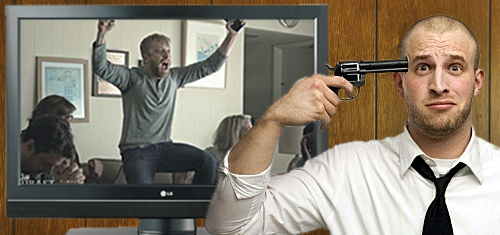 Daily fantasy sports operators DraftKings and FanDuel spent a combined $107m on television ads in the month of September.
Daily fantasy sports operators DraftKings and FanDuel spent a combined $107m on television ads in the month of September.
According to estimates compiled by iSpot.tv, DraftKings was the clear Daddy Warbucks of the two, spending an estimated $60.1m on TV ad buys in the first 29 days of the month. The money allowed DraftKings’ 30-second commercials to run an incredible 16,259 times, which equates to over 135 hours or five-and-a-half DAYS of airtime.
The bulk ($23.6m) of DraftKings’ spending was devoted to running ads during National Football League game broadcasts. College football broadcasts ate up a further $8m of DraftKings’ budget, while $2m was spent on ESPN’s SportsCenter and $1.6m on NBC’s Sunday night pre-game show. In case you had any doubts as to DraftKings’ target demographic, the highest non-sports ad buy was $1.36m on Comedy Central’s pantheon of puerility, South Park.
By comparison, FanDuel was the picture of restraint, spending a mere $46.9m, although it spent more ($26.7m) on NFL broadcasts than DraftKings. College football earned $3.76m from FanDuel, while SportsCenter made do with $1.18m. Meanwhile, FanDuel’s largest non-sports buy was for reruns of the reality show Cops. “Bad bets, bad bets, whatcha gonna do….”
FanDuel’s total airwave hogging amounted to a comparatively mild 79 hours, or about as much time as you’d need to watch the entire run of The Sopranos. But FanDuel has surpassed DraftKings since the NFL season began, with the most recent seven-day chart showing FanDuel leading all companies with a $17.3m outlay, while DraftKings has fallen to sixth with just under $13m.
After posting some serious overlays in the first couple weeks of the new NFL season, both DraftKings and FanDuel managed to fill their marquee contests this past Sunday. It helped that DraftKings had reduced its original $10m Millionaire Maker to $7m, while FanDuel is feeling sufficiently cocky to have upped its $5m guarantee to $6m for Week 4.
So is all this frenzied marketing paying off? Not if you gauge success by profits, which neither site has managed to produce so far. And the entire sector has yet to deal with regulatory compliance costs, which haven’t yet arrived but are definitely in the mail. The CEOs of both firms are likely just trying to hold on until they can go public, after which they can take their winnings and leave the profit problem to someone else.
